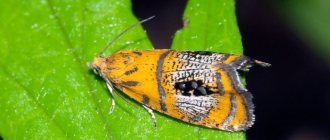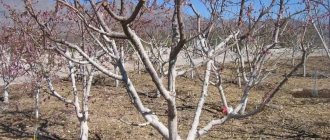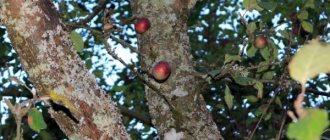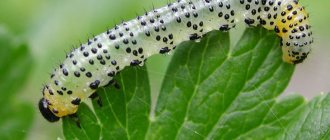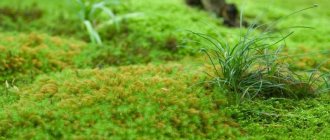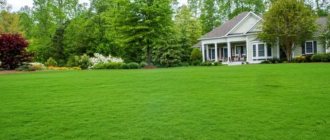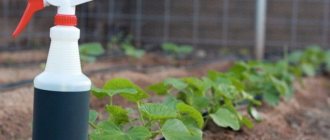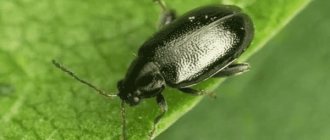Photos and names of weeds on the lawn
Weeds are annual or perennial grasses that spoil the appearance of your lawn. The greatest danger is posed by creeping plants that quickly fill the free space. Weeds are resistant to cold and drought, take nutrients from the soil, and attract pests.
The most common weeds on the lawn:
- Dandelion. A herbaceous perennial with a powerful root up to 60 cm long. The leaves of the plant are pinnate, dissected, and collected in a rosette. Its flowers are yellow, in the form of baskets. The perennial blooms begin in March and lasts until June. As a result, achenes are formed that are easily dispersed by the wind.
- Nettle. Perennial plant with entire leaves. It reaches a height of 0.6 - 2 m. Its stems and leaves are covered with burning hairs. Due to its long rhizomes, nettle forms dense thickets. It prefers moist soils rich in nitrogen.
- Clover. Perennial plant with branched shoots. Its leaves are trifoliate and round in shape. Loose, spherical inflorescences of pink or white color. The flowering of the plant lasts from June to September. Clover prefers soils poor in nitrogen. It often freezes in winter and leaves vacant areas on the lawn.
- Creeping wheatgrass. A perennial with cord-like rhizomes, which are located at a depth of 5 - 15 cm. Its stems reach a height of 0.4 - 1.5 m. The leaves are linear, flat, the flowers are collected in spikelets. Wheatgrass draws a lot of water from the soil and absorbs useful microelements. As a result, the fertile layer of soil is depleted.
- Woodlice, or chickweed. Herbaceous annual plant that prefers moist areas. Its shoots branch well and spread along the ground. Small white flowers are presented in the shape of small stars. Woodlice appears in early spring and blooms until late autumn. The fight against it is complicated due to the large number of seeds. Important! Woodlice produces up to 20 thousand seeds per year. They remain viable for 2 - 5 years.
- White pigweed. A common annual plant with high growth vigor. The plant branches well, reaching a height of 2 m. Its leaves are elongated, alternate, with jagged edges. Flowers are collected in panicles. This species develops quickly in moist soils rich in fertilizers. Its powerful root system consumes a lot of moisture.
- Creeping buttercup. A herbaceous perennial that grows in moist, shaded areas. Its rhizome is short, branched, and the stems reach a height of 15 - 40 cm. The flowers consist of 5 yellow petals.
- Common moth. Perennial with horizontal creeping root. Its straight stem grows up to 1 m. The leaves are trifoliate, pointed, oblong. Its inflorescences are in the form of a complex umbrella; small flowers are white. The perennial prefers rich soils and can grow in the shade.
- Field mustard. This is an annual weed that grows in height up to 10 - 100 cm. Its shoots are erect, its leaves are ovate, with uneven teeth. The yellow inflorescences are brush-shaped. The plant's seeds remain in the soil for 10 years and germinate under favorable conditions: high temperature and humidity.
Features of killing weeds on the lawn
Weed control on the lawn is systematic. Their seeds are carried by the wind, birds, and animals. They enter the site along with soil and organic fertilizers. To remove weeds from the lawn, treatments are carried out several times throughout the season. The best results are obtained by alternating different methods.
The following methods are used to get rid of weeds:
- weeding by hand or using a special tool;
- regular haircut;
- treating the lawn against weeds with herbicides;
- use of traditional methods.
Weeding of the lawn begins 20 days after sowing. At this time, the root system of the weeds is still poorly developed. Therefore, they can be easily removed manually. Dandelions and other plants with a developed root system are dug up using a narrowed scoop. Weeding is done throughout the season. This method is quite effective, but labor-intensive. If the soil is damaged as a result of processing, it is compacted and watered.
Regular mowing helps control chickweed, bluegrass and other annual weeds. After cutting, lawn grasses grow side shoots and root systems. Weeds do not get the opportunity to develop and die.
Special preparations – herbicides and folk remedies – help fight weeds. They contain substances that inhibit grass growth. Treatment is carried out before sowing grass or when unwanted plants appear.
Blackout
It is vital for plants to receive enough light. If you limit the amount of sunlight, the weeds weaken and stop growing.
The area with weeds is covered with darkened material and sprinkled with earth. Plants deprived of light quickly die.
One of the main enemies of a gardener is weeds. It takes a lot of effort and patience to fight them. Plants have vitality and endurance, they are able to suppress the growth of most crops.
Weeds deteriorate the condition of the soil, the quality of crops and cause insects. Therefore, it is necessary to get rid of them in time.
But there is also a positive side to the appearance of such vegetation. Weeds are an indicator of soil condition. So, wheatgrass and woodlice love slightly acidic soil, and plantain grows on dense and heavy soil. Wormwood prefers dry soil, while buttercup prefers moist soil.
By determining what vegetation appears on the site, you can assess the condition of the soil and take appropriate improvement measures.
How to control weeds in your lawn
Removing weeds from the lawn is carried out using various methods. Herbicides that consist of chemicals are considered the most effective. Folk remedies are safe and easy to use. Agricultural practices are used to maintain the lawn in good condition.
How to remove weeds from your lawn using chemicals
Special products have been developed to control weeds on the lawn. According to the method of action, there are two types of herbicides: continuous or selective action. Preparations from the first group destroy any vegetation. They are used for cleaning ditches, roadsides, and sports fields.
Important! Selective herbicides are chosen for the lawn. They damage only weeds and do not harm the main coating.
All herbicides are also divided into two large groups:
- contact – when they come into contact with a weed, they damage its tissues;
- systemic - penetrate inside the plant and spread throughout its organs.
Herbicides work better on young plants. Therefore, treatments are most effective in the spring, when the first shoots appear. The drugs are supplied in the form of granules or liquid. They are diluted with water to obtain the required concentration.
Herbicides are used in various ways: by spraying weeds or adding them to moist soil. When dried, the active ingredients remain in the soil and have no effect on the plants. If the solution is applied by spraying, then do not wash it off with water for 2–4 hours. Therefore, the best time for treatment is after rain or watering.
The lawn is treated with herbicides immediately before planting. This procedure prevents the growth of excess grass and simplifies further maintenance. Before planting the desired herbs, the soil is treated with broad-spectrum herbicides. The weeds will dry out in 7 to 10 days, after which they can be easily removed. The soil is left for a month, then it is again cleared of excess grass. If necessary, the procedure is repeated.
How to remove weeds from the lawn using traditional methods
Folk remedies help to destroy weeds on the lawn: soda, soap, salt, vinegar. They are commercially available and safe for humans. However, they are used selectively, only on individual plants. When these substances enter the soil, they negatively affect its fertility.
Folk remedies against weeds on the lawn:
- Salt solution. Add 1 kg of salt to a large bucket of water. The solution is mixed well and used for irrigation.
- Laundry soap and soda. A bucket of warm water requires 1 handful of soda and a piece of crushed soap. The product is mixed, and then the weeds are watered.
- Vinegar solution. To remove individual plants, mix vinegar with a concentration of 9% and lemon squeeze in a ratio of 3:1. After treating the lawn, be sure to fertilize it in the form of wood ash, since vinegar acidifies the soil.
- Vinegar, soap and salt. The most gentle method that does not affect soil fertility. For a bucket of water, 1 liter of vinegar with a concentration of 15%, a piece of grated soap and 150 g of salt is enough. The solution is thoroughly mixed. After watering, it is recommended to add wood ash.
Agrotechnical measures to control weeds on the lawn
Compliance with agricultural technology is one of the prerequisites for weed control. Conditions are created on the site that are favorable for the growth of the necessary herbs.
The likelihood of weeds appearing is reduced when the following conditions are met:
- High quality turf. Lawn grass is purchased from reliable suppliers. This material does not contain weed seeds.
- Air entry into the soil. High humidity creates conditions for seed germination and the appearance of pests. To aerate the soil, the lawn is pierced with a pitchfork.
- A haircut. The procedure has a positive effect on lawn grasses. At the same time, the weeds do not receive enough nutrition. Plants are trimmed to a height of 4 - 5 cm.
- Weeding. It is more convenient to dig up single weeds by hand without the use of herbicides. They are removed completely, along with all the roots.
- Fertilizing with nitrogen substances. Most weeds cannot tolerate excess nitrogen. For fertilizer I use urea, nitrophoska, ammonium nitrate.
- Mulching with sawdust. In autumn and spring, the lawn is covered with sawdust. Weeds cannot penetrate through such a dense layer.
Advice! Combing the lawn with a rake gives good results. This is how grasses with branched stems are removed.
Selective herbicides
How to kill weeds on your lawn without damaging the tender green grass? This is the question that puzzles many land owners. And in this case there can be only one answer: you need to use selective herbicides. Among these chemicals, the following drugs are highly effective:
Lontrel 300
The active ingredient of the drug is clopyralid, a hormone that limits the growth of weeds and destroys them. The drug is highly effective in controlling annual and perennial weeds, including dandelion, sedge, and plantain.
The herbicide should be used after mowing the lawn early in the morning or after sunset. The substance is applied by spraying onto the above-ground parts of plants. The substance is quickly absorbed, and you can see the result on the treated weeds within 2 weeks.
Deimos
Treating the lawn against weeds with Deimos allows you to remove hated broad-leaved plants. The spectrum of action of this drug allows you to eradicate about 100 different types of weeds at once. Weeds such as woodlice, clover, dandelion and others cannot resist it.
The active ingredient of the drug is dimethylamine salt, which is safe for plants and humans. After dissolving in water, the chemical is used to spray the lawn. After just 2 weeks, the weeds will dry out and will no longer spoil the green lawn. They can be removed mechanically without much difficulty.
Hacker
This herbicide for lawn grass is relatively new, but is already widely popular due to its high effectiveness in controlling many weeds. The active substance of the chemical penetrates the leaf blade of the plant and blocks its growth. As a result of this effect, within a week the weeds turn yellow and dry out, while the lawn grass remains healthy.
The given selective action herbicides for lawns against weeds are characterized by high efficiency and environmental safety. They can be used to treat lawns, including playgrounds, parks, and personal plots. Their safety is confirmed by the fact that they can be used not only to remove weeds from the lawn, but also from beds with vegetable and berry crops.
You can see the process of treating a lawn with selective herbicides in the video:
Important! Herbicides are hazardous substances and work with them must be carried out using personal protective equipment.
The best herbicides for lawn grass against weeds
Lawn weed killers act quickly and effectively. To treat the soil before planting grass, herbicides are chosen that remove all vegetation. To remove unwanted grasses from an area, selective agents are used.
Lontrel
A systemic herbicide that penetrates into the plant and disrupts its vital functions. Supplied as a solution. Effectively destroys weeds of the Compositaceae family, buckwheat, dandelions, etc. Does not damage lawn grass and strawberries.
For treatment, prepare a solution containing 3 ml of the drug per 5 liters of water. Weeds are sprayed after the first mowing of the lawn. Per 100 sq. m consumption of the drug is 5 liters. It is not recommended to visit the lawn for the next 3 days.
Gazontrel
An effective herbicide that suppresses the growth of one- and two-year-old plants. Works well against chamomile, knotweed, buckwheat, and dandelions. The active substance penetrates the foliage and blocks further development of the grass.
Spraying of weeds is carried out after the first mowing. The drug Gazontrel is sold in 3 ml ampoules. For 5 liters of water, 6 ml of herbicide is sufficient. This volume is enough to process 100 square meters. m of lawn.
Lintur
Herbicide Lintur is a systemic herbicide that penetrates plant tissue and blocks their growth. It has the form of granules that are easily soluble in water. The result is a suspension for spraying weeds. The product effectively protects the lawn from problem weeds, which include pigweed, chamomile, and various types of thistle.
Spraying is carried out in May or June, 4 days after cutting the grass. Treatment is allowed in early autumn. For 5 liters of water take 1.8 g of herbicide. After dissolving in water, the product is applied to unwanted plants. For 3 days after treatment, people and animals are prohibited from being near the lawn.
Deimos
Deimos herbicide effectively fights one- and two-year-old weeds. The active substances enter the plant through the roots and aerial parts. Deimos is compatible with other herbicides, while remaining safe for crop rotation.
To treat an area, add 20 ml of product to 3 liters of water. The resulting volume is enough to spray 100 square meters. m of lawn. People and pets are not allowed into the site for 3 days. The use of the solution is prohibited near bodies of water.
Hacker
Herbicide in the form of water-soluble granules. Has a systemic effect on seedlings. Copes well with plants that are difficult to eradicate from the site: dandelions, buttercups, etc. Destroys both the root part and shoots. Does not conflict with other drugs in tank mixtures.
Add 5 g of substance to 10 liters of water. The lawn is sprayed 2 days after cutting. After treatment, the lawn is not visited for 3 days.
Agrokiller
Agrokiller herbicide is an aqueous solution that is used to control annual and perennial weeds. The product has a contact and systemic effect. The drug is sold in the form of a liquid, which is diluted with water. The product works at different temperatures. To prepare a solution, add 40 ml of herbicide to 3 liters of water.
Attention! Agrokiller herbicide is suitable for treating soil under a lawn. It starts 2 weeks before planting the seeds.
Tornado
Herbicide Tornado has a continuous effect on vegetation. It even copes well with bushes. The product is safe for crop rotation. The drug is supplied in liquid form, in bottles and canisters. Tillage is carried out 10 - 14 days before sowing lawn grass. Take 50 ml of the drug per 3 liters of water. The resulting solution is consumed per 100 sq. m area.
Continuous herbicides
As has already become clear, continuous action herbicides destroy all vegetation on the lawn, which means they can only be used during the period of preparing the soil for sowing grass seeds or to destroy old plantings. The most effective and safe, from an environmental point of view, continuous action herbicides are:
Tornado
This chemical is an aqueous solution of glyphosate. The drug is produced in ampoules with volumes from 5 to 1000 ml. The substance is used to spray plants with a solution prepared on a water basis. Depending on the exact name, the drug "Tornado" is diluted in accordance with the instructions.
After using the Tornado herbicide, all vegetation on the lawn will be destroyed within 3 weeks. The drug itself will remain in the soil for 2 months.
Herbicide "Tornado" can be used at any air temperature and weather. At the slightest contact with the leaves of a plant, it penetrates deep into the root, gradually destroying it. Using the Tornado herbicide, you can get rid of not only weeds, but also shrubs and tall trees. The chemical is used in the agricultural industry, since the lack of toxicity makes it possible to sow vegetable crops the very next year after processing the fields. If necessary, Tornado herbicide can be stored for 5 years. Analogues of "Tornado" are the drugs "Glisol", "Urogan", "Agrokiller" and some others.
Important! Glyphosate was recognized as a “possible carcinogen” in 2015, so it should not be used to cleanse soil for crops.
Diquat
Weeds are removed from the lawn by spraying with an aqueous herbicide solution. Once on grass leaves, diquat is synthesized into hydrogen peroxide, which destroys plant cells and dries them out. The chemical decomposes quickly and does not harm insects or soil microflora.
Broadcast herbicides can be used before seeding lawn grass or to remove all turfgrass from a lawn. If you decide to develop land on the site of a lawn for the subsequent cultivation of cultivated plants, then it is preferable to use a less toxic preparation that will not damage the quality of the grown vegetables and berries. “Dikat” is the best option for such purposes, however, its disadvantage may be its relatively low effectiveness in controlling weeds.
An overview of some other effective herbicides of continuous and selective action can be seen in the video:
Tips for treating your lawn for weeds
The following tips will help you effectively clear your lawn of weeds:
- do not carry out treatment in rainy weather;
- strictly adhere to dosages;
- isolate children and animals from the area where herbicides are sprayed;
- herbicides should be kept in a dry, dark place, away from food;
- be sure to use personal protective equipment;
- After cutting the grass, herbicides can be applied only after 3 days.
When working with herbicides, take precautions. The respiratory and visual organs are protected with respirators and goggles. Be sure to use gloves and closed clothing to protect your skin from contact with the solution.
Don't expect quick results from herbicides. The products act on weeds for 1 - 2.5 months. At the same time, their effectiveness is very high: the roots, bulbs, and aerial parts of weeds are destroyed. Treatments should not be combined with fertilizing. It is better to wait 7-10 days between procedures.
Folk methods of struggle
Not every gardener, when thinking about how to get rid of weeds on the lawn, will choose herbicides. Safer options can help here, although it will take some time to make a suitable mixture.
Vinegar and salt
You will need:
- vinegar - 5 tablespoons;
- salt – 2 tablespoons;
- hot water – 1 liter.
All components are mixed, there is no need to wait until the water cools down, you need to immediately start watering the weeds. It is recommended to use vinegar 9 or 6%.
Citric acid and vinegar
In this recipe, vinegar and acid are mixed at a ratio of 3:1, or simply diluted with vinegar and water (1:2), after which the problem area is treated.
Salt and rubbing alcohol
A good remedy for weeds on the lawn is simple salt. To destroy each plant you will need 1 tablespoon of this product, after a while the green pests will begin to die.
As for medical alcohol, before using it for irrigation, it is recommended to mix it with water using a ratio of 1:10.
Worth remembering. All folk remedies are used for targeted application so that there is no harm to cultural plantings.
